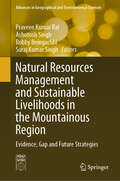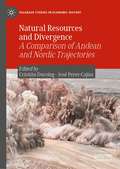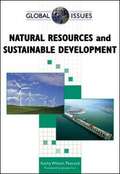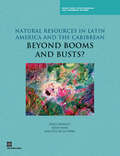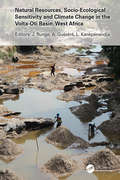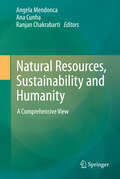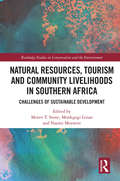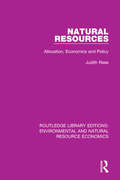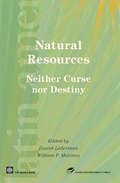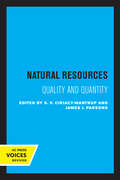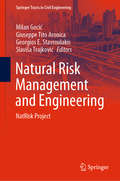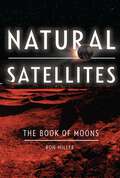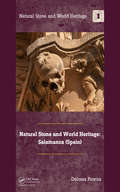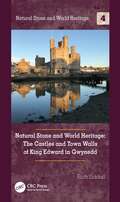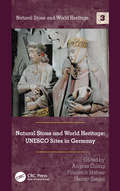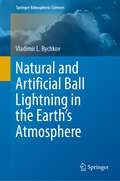- Table View
- List View
Natural Resources Management and Sustainable Livelihoods in the Mountainous Region: Evidence, Gap and Future Strategies (Advances in Geographical and Environmental Sciences)
by Praveen Kumar Rai Ashutosh Singh Suraj Kumar Singh Bobby BeingachhiThis book explores the relationships between natural resources management, sustainable livelihoods, and integrated watershed management in the context of the mountainous region, especially in the northeastern region of India. The book also sheds light on the current state of regional issues, identifies gaps in the existing practices and proposes future policies for effective conservation and sustainable development.The environmental degradation in the northeastern region of India is basically attributed to the increasing biotic pressure on the fragile ecosystems in the absence of suitable investments and proper management practices to enhance and conserve the natural resources. Population growth and poverty on the one hand and the pressure of rising demand from wealth and consumerism on the other hand, have been exerting powerful pressure on the ecosystems. Natural resources planning and management and sustainable livelihoods through integrated watershed management is not just a technical challenge; it is also a social challenge. The book is a valuable resource for policymakers, researchers, practitioners and stakeholders involved in natural resource management, sustainable development and watershed management in the Himalayan region.
Natural Resources and Divergence: A Comparison of Andean and Nordic Trajectories (Palgrave Studies in Economic History)
by Cristián Ducoing José Peres-CajíasIs the 'natural resource curse' destiny? Are different ways to link natural resources and economic development? Using two particular regions as case studies, this edited collection examines the divergent development paths of natural resource rich countries over the past two centuries. Bolivia, Chile and Peru are neighbour states with a common history and are globally known by their mining endowments. Norway and Sweden have also a strong common history, and different natural resource endowments (forestry, mining and fishing) are essential to understand their current economic success. By comparing natural resource management in the long run in these two divergent regions, this book can help rethink how developing countries can better take advantage of their natural resource endowments. Specifically, the book examines the interaction between natural resources and different key determinants of long-term development: trade, fiscal policy, sustainability, human capital accumulation and business strategies.
Natural Resources and Local Livelihoods in the Great Lakes Region of Africa
by An Ansoms Stefaan MarysseFragile but progressive post-conflict reconstruction has allowed for a new growth-oriented logic in the Great Lakes Region of Africa. However, the opportunities provided by economic development are not being equally distributed. A struggle exists between large-scale and local small-scale actors that is particularly prevalent in the rural environment, where the increasingly prevalent scramble for natural resources impacts heavily upon local livelihoods. This is occurring both in the agricultural sector and in the mineral sector. This book analyses the opportunities and constraints for local actors' participation in economic growth. The book first looks into the contemporary challenges with regard to land relations and local livelihoods in the Democratic Republic of the Congo (DRC), Burundi and Rwanda. It then goes on to consider the ambiguities that characterise the relationship between mining and development in the DRC. This book is essential reading for students, researchers and policy makers workingon rural development in Africa and those interested in understanding post-conflict reconstruction and the way in which local level dynamics relate to the broader political economy. "
Natural Resources and Public Property Under the Canadian Constitution (The Royal Society of Canada Special Publications)
by Gerard La ForestThe controversy aroused by the Supreme Court's decision on offshore mineral rights emphsizes the importance of the public domain in the workings of the Canadian constitution. Public property is important to the provinces not only for its revenues, but also because it provides them with a powerful instrument for control of their economic and political destinies and strengthens their position in relation to federal authorities. The provisions of the British North America Act and other constitutional instruments relating to natural resources and public property are examined thoroughly in this series of lectures given to doctoral systems at the Faulte de droit of the Universite de Montreal. Professor La Forest studies ownership of mines and minerals, navigable waters, public harbours, fisheries and Indian lands, as well as the currently controversial offshore mineral rights. He notes the political imlications of the partition of proprietary rights and explores the areas of conflict between the federal and provincial governments. Also included is a discussion of the power of expropriation, and, because public property involves public monies, lending and spending powers receive attention.In these lectures, Professor La Forest traces public domain in Britain from the time when the monarch controlled all the land, to his surrender of this control to parliament in return for a civil list, and to the similar surrender to the legislatures of the British North American colonies in connection with the struggle of responsible government.The collection of lectures is essential reading for any serious student of the constitution and will be very useful to all who are interested in the increasingly important law of natural resources in Canada.
Natural Resources and Sustainable Development
by Kathy Wilson PeacockJeremy Carl (Program on Energy and Sustainable Development, Stanford U.) introduces this volume by noting that whether development is viewed as more or less sustainable depends on how "sustainable development" is defined. Peacock (a generalist writer/ editor) presents a balanced introduction to this pivotal contemporary environmental, political, and social concept. Starting with factors contributing to the devastation of New Orleans by Hurricane Katrina, she examines issues of urbanization, over- consumption, and overpopulation from US and global perspectives. Written specifically with high school students in mind, the volume includes source documents, an annotated bibliography, chronology from prehistory to the near future, and a glossary. Annotation ©2008 Book News, Inc., Portland, OR (booknews.com)
Natural Resources and the Environment: Economics, Law, Politics, and Institutions
by Mark KanazawaNatural Resources and the Environment: Economics, Law, Politics, and Institutions provides a new approach to the study of environmental and natural resource economics. It augments current contributions from the fields of public choice, law, and economics, and the burgeoning field of what used to be called the "New Institutional Economics," to describe, explain, and interpret how these new developments have been applied to better understand the economics of natural resources and the environment. This textbook takes a multi-disciplinary approach, which is essential for understanding complex environmental problems, and examines the issue from not only an economic perspective, but also taking into account law, politics, and institutions. In doing so, it provides students with a realistic understanding of how environmental policy is created and presents a comprehensive examination of real-world environmental policy. The book provides a comprehensive coverage of key issues, including renewable energy, climate change, agriculture, water resources, land conservation, and fisheries, with each chapter accompanied by learning resources, such as recommended further reading, discussion questions, and exercises. This textbook is essential reading for students and scholars seeking to build an interdisciplinary understanding of natural resources and the environment.
Natural Resources as Capital (The\mit Press Ser.)
by Larry KarpAn introduction to the concepts and tools of natural resource economics, including dynamic models, market failures, and institutional remedies.This introduction to natural resource economics treats resources as a type of capital; their management is an investment problem requiring forward-looking behavior within a dynamic setting. Market failures are widespread, often associated with incomplete or nonexistent property rights, complicated by policy failures. The book covers standard resource economics topics, including both the Hotelling model for nonrenewable resources and models for renewable resources. The book also includes some topics in environmental economics that overlap with natural resource economics, including climate change.The text emphasizes skills and intuition needed to think about dynamic models and institutional remedies in the presence of both market and policy failures. It presents the nuts and bolts of resource economics as applied to nonrenewable resources, including the two-period model, stock-dependent costs, and resource scarcity. The chapters on renewable resources cover such topics as property rights as an alternative to regulation, the growth function, steady states, and maximum sustainable yield, using fisheries as a concrete setting. Other, less standard, topics covered include microeconomic issues such as arbitrage and the use of discounting; policy problems including the “Green Paradox”; foundations for policy analysis when market failures are important; and taxation. Appendixes offer reviews of the relevant mathematics. The book is suitable for use by upper-level undergraduates or, with the appendixes, masters-level courses.
Natural Resources in European History: A Conference Report (Routledge Revivals)
by Antoni Mączak and William N. ParkerNatural Resources in European History pulls together several papers from the Bellagio Conference on Natural Resources and Economic Development which took place in 1977. Originally published in 1978, this report focuses on papers exploring the history of natural resources in Continental Europe presenting research on how resources were traded, collected and depleted between the fifteenth and nineteenth century. This title will be of interest to students of Environmental Studies or with an interest in Environmental History.
Natural Resources in Latin America and the Caribbean: Beyond Booms and Busts?
by John Nash Augusto De la Torre Emily SinnottPolicy makers in many countries in the Latin American and Caribbean region have found it challenging to determine how to treat natural resource commodity production and how to manage the recurrent cycles of booms and busts. 'Natural Resources in Latin America and the Caribbean: Beyond Booms and Busts?' addresses the major concerns associated with commodity dependence, summarizing the state of the art in existing literature and filling in the knowledge gaps with new analysis. The report finds that some commonly accepted negative effects of dependence on natural resources are largely myths, while some are realities. But the authors find that all the effects can be managed, and they provide practical advice on how to do so. Issues covered include long-term fiscal growth, fiscal volatility, institutional impacts, and environmental and social effects. The report analyzes the implications for the region's development and policies. 'Natural Resources in Latin America and the Caribbean: Beyond Booms and Busts?' will be of interest to policy makers, academics, and analysts, as well as others interested in the economics of commodity markets and their role in economic development.
Natural Resources, Inequality and Conflict
by Lars-Erik Cederman Hamid E. AliThis edited volume explores the link between natural resources and civil conflict, focusing especially on protest and violence in the context of mining and the extraction of minerals. The primary goal of the book is to analyze how the conflict-inducing effect of natural resources is mediated by inequality and grievances. Given the topicality of the current boom in mining, the main empirical focus is on non-fuel minerals. The work contains large-N studies of fuel and non-fuel resources and their effect on conflict. It presents case studies focusing on Zambia, India, Guatemala, and Burkina Faso, which investigate the mechanisms between the extraction of natural resources and violent conflict. Finally, the book provides a summary of the previous analyses.
Natural Resources, Socio-Ecological Sensitivity and Climate Change in the Volta-Oti Basin, West Africa
by Jürgen RungeThis book presents the outcome of an interdisciplinary and international workshop supported by the Volkswagen Stiftung (funding line ‘Knowledge for Tomorrow’) on the topic of ‘Natural Resources, Socio-Ecological Sensitivity and Climate Change in the Volta-Oti Basin, West Africa’. The conference was jointly organised by Goethe-University Frankfurt (Germany) and the University of Kara (Togo) held from March 6 to 8, 2019 in northern Togo. It aimed to strengthen capacities of junior scientists from the sub-region, exchange and mobilise theoretical and methodological background from various scientific fields (Botany, Construction, Geology, Geography, Infrastructure, Politics, Remote Sensing, Sociology and Urban Planning). One goal was to deliver reliable elements for ongoing and profound environmental analyses that lie outside the common questions of the academic and civil society stakeholders. Ecosystem fragmentation and deforestation in West Africa are mainly triggered by humans such as agriculture and small-scale forest disturbances for charcoal and firewood production. Increasing population pressure, declining of carrying capacity and demand for agricultural land caused the reduction of land conservation capacities, even in protected areas. The complexity of interactions between environmental and socio-ecological systems and subsequent effects (sensitivity) has raised ongoing international awareness in light of ongoing climate change. By the example of natural resources, land use and stakeholders’ perceptions within the Volta-Oti Basin the book’s proceedings present, discuss and distribute new findings that will sustainably stimulate the international debate. The workshop also intended to overcome national borders and language barriers between the Anglophone (Ghana) and the Francophone (Benin, Burkina Faso, Ivory Coast, Togo) research communities, and supported better West African cooperation and networking. The young as well as the established partners formed new collaborations, and the event at the University of Kara (Togo) was a truly unique opportunity for all involved, not only to discuss science, but also to assess applied and best future management practices for the Oti-Volta Basin in West Africa.
Natural Resources, Sustainability and Humanity: A Comprehensive View
by Ana Cunha Angela Mendonca Ranjan ChakrabartiShortly, this book is the written up-graded version of the topics discussed during the Small Meeting of the 2nd International School Congress: Natural Resources, Sustainability and Humanity, held in Braga, Portugal, 5-8 May 2010 with the diverse participation of scientists, educators and governmental representatives. The Earth hosts an immense ecosystem, colonized by millions of species for billions of years but only for a few tens of thousands of years by humans. Environmental history tells though that it was humankind that shaped the environment as no other species. History, geography, religion and politics among other reasons have differentiated populations with respect to access to safe food and water, education, health, and to space and natural resource utilization. The globalization era of trade, information and communication is shortening distances and increasing overall wealth, but, as is pointed out in this book, it is also contributing to the propagation of diseases, and to the modification or even destruction of native ecosystems by exotic invasive species. Man is the only species that has the perception of its history, evolution, of the consequences of its decisions, and that there is a future ahead. It is also the only species that has the potential to change it. This awareness can be a source of anxiety and contradictory behaviours, but it is also the key to changing attitudes towards the construction of a common sustainable home, by committed education, interdisciplinary approaches, mobilization and empowerment of people and political consonant actions.
Natural Resources, Tourism and Community Livelihoods in Southern Africa: Challenges of Sustainable Development (Routledge Studies in Conservation and the Environment)
by Naomi Moswete Moren T. Stone Monkgogi LenaoThis book examines the connections between natural resources, tourism and community livelihood practices in Southern Africa, highlighting the successes and constraints experienced over the last 50 years. Questioning how natural resources, tourism and community livelihoods relations can positively contribute towards development efforts, this book adopts an interdisciplinary approach to understand socio-ecological systems that characterize the dynamics for sustainable development. It explores the history of conservation and natural resource management in Southern Africa and traces the development and growth of nature-based tourism. Boasting a wide range of tourism landscapes, including national parks, wetlands, forests and oceans, the book draws on case studies from a variety of Southern African countries, including Botswana, Namibia and South Africa, and considers the political challenges for implementing policies and practices. Furthermore, it analyses broader issues such as the impact of climate change, human–wildlife co-existence and resulting conflicts, poor access to funding and poverty in local communities. The book argues that the links between conservation and livelihoods can be best understood by considering the different approaches to reconciling the demands of conservation and livelihoods that have evolved over the past decades. Containing contributions from natural and social sciences the book provides guidance for practitioners and policymakers to continue to shape policies and practices that are in line with the key tenets of sustainable development. It will also be of great interest to students and scholars researching Southern Africa, sustainable tourism and conservation.
Natural Resources: Allocation, Economics and Policy (Routledge Library Editions: Environmental and Natural Resource Economics)
by Judith ReesIn this book, first published in 1990, Judith Rees considers the spatial distribution of resource availability, development and consumption, and the distribution of resource-generated wealth and welfare. Showing that there are no simple answers, she analyses the complex interactions between economic forces, administrative structures and political institutions. This well-structured text is essential reading for upper-level students in geography, environmental planning, economics and resource management.
Natural Resources: Neither Curse nor Destiny
by Daniel Lederman William F. Maloney'Natural Resources: Neither Course nor Destiny' brings together a variety of analytical perspectives, ranging from econometric analyses of economic growth to historical studies of successful development experiences in countries with abundant natural resources. The evidence suggests that natural resources are neither a curse nor destiny. Natural resources can actually spur economic development when combined with the accumulation of knowledge for economic innovation. Furthermore, natural resource abundance need not be the only determinant of the structure of trade in developing countries. In fact, the accumulation of knowledge, infrastructure, and the quality of governance all seem to determine not only what countries produce and export, but also how firms and workers produce any good.
Natural Resources: Quality and Quantity
by James J. Parsons S. V. Ciriacy-WantrupThis title is part of UC Press's Voices Revived program, which commemorates University of California Press’s mission to seek out and cultivate the brightest minds and give them voice, reach, and impact. Drawing on a backlist dating to 1893, Voices Revived makes high-quality, peer-reviewed scholarship accessible once again using print-on-demand technology. This title was originally published in 1967.
Natural Risk Management and Engineering: NatRisk Project (Springer Tracts in Civil Engineering)
by Milan Gocić Giuseppe Tito Aronica Georgios E. Stavroulakis Slaviša TrajkovićThis book summarizes the research being pursued as part of the Erasmus+ CBHE KA2 project entitled "Development of master curricula for natural disasters risk management in Western Balkan countries” (NatRisk), which aims to educate experts on the prevention and management of natural disasters in the Western Balkan region in line with national and EU policies. The project has successfully developed and implemented master curricula and educational training in the field of natural disasters risk management, and a methodology for the identification and prevention of natural disasters. Consisting of 11 chapters, the book analyzes and discusses topics such as risk assessment tools and quality methods, the different approaches for civil-military collaboration, natural disasters risk management in Bosnia and Herzegovina, leadership models for managing crises resulting from natural disasters, natural disasters in industrial areas, natural risk management in geotechnics, flood risk modeling, adaptive neuro-fuzzy inference models for flood prediction, collapse prediction of masonry arches, an algorithm for fire truck dispatch in emergency situations, and processing drought data in a GIS environment.
Natural Satellites: The Book of Moons
by Ron MillerFor centuries, astronomers have placed a special importance on the other planets of the solar system. But with the advent of spacecraft and the tremendous missions undertaken by the Voyager and Cassini probes, astronomers have discovered that the natural satellites of the planets—the solar system's moons—are some of the most extraordinary places imaginable. There are moons with towering geysers, erupting volcanoes, and subterranean oceans of warm, mineral-rich water. Some of the highest mountains and deepest canyons can be found on moons. There are moons that have shattered into pieces and then reassembled. There is even a moon where it rains rocket fuel. Recently, scientists have turned to moons for answers in their investigations of the origins of the solar system and the evolution of life on our own planet. Featuring full-color, scientifically accurate illustrations by NASA artist Ron Miller, Natural Satellites: The Book of Moons chronicles these investigations and the questions we have yet to answer in our exploration of the solar system's moons.
Natural Stone and World Heritage: Salamanca (Spain) (Natural Stone and World Heritage)
by Dolores PereiraHeritage stones are those stones that have been used for many years, even centuries, to build the historic buildings and monuments of places around the world. Some of these stones are still being used for construction, but others are no longer used, either because quarries were exhausted or closed or because architects and constructors do not know about their particularities and importance. Several scientific papers discuss many of these stones, and a number of papers are currently being prepared, but this book is the first to emphasize the importance and significance of natural stone in the construction of a city, Salamanca, recognized as a World Heritage Site by UNESCO since 1988. In light of this recognition, Salamanca has a duty to preserve all historic buildings that make up the city by restoring those that are starting to deteriorate centuries after their construction. <P><P>This book describes the buildings, the stones (all quarried centuries ago in the surrounding area), and the stone quarries, some of them inactive for many years, but that should still allow extraction of blocks on demand to restore and replace damaged specimens in the buildings, preserving the very character that saw the city receive recognition by UNESCO in the first place. There are many other places around the world that should follow this initiative and disseminate the importance of their heritage stones. This book will be of interest to professionals and academics in Geology, Engineering, architectural and artistic work in stone, both construction and conservation, but also to the general public.
Natural Stone and World Heritage: The Castles and Town Walls of King Edward in Gwynedd (Natural Stone and World Heritage)
by Ruth SiddallThis book is about the stone used to build the castles of Edward I in North West Wales. It provides a description of the available geological resources and the building materials used in the construction of Caernarfon, Conwy, Harlech and Beaumaris Castles. It takes a broad view of this subject, placing the stone used in the castles in the context of both earlier and later buildings across the region of study, from the Neolithic up until the present day. The book will serve as a useful source book for geologists, archaeologists, architects, representatives of the natural stone industry, historians and cultural heritage management professionals specifically and for academic and non-academic communities, travellers and tourism industry operators in general.
Natural Stone and World Heritage: UNESCO Sites in Germany (Natural Stone and World Heritage)
by Angela Ehling Friedrich Häfner Heiner SiedelThere are many UNESCO World Heritage Sites in Germany. Most of them are built with natural stones. These sites are commonly presented to the public with a lot of information regarding historical, cultural and artistic aspects. Mostly, there is no focus on the main building material if it concerns natural stones. This work aims to show that it is precisely the natural stone that lends the sites their distinctive character. The used stones demonstrate the context and the interaction with the geology of the surrounding countryside as well as possibilities of transport and treatment. They reflect the culture and society at the time of the building phases. The second part of the work presents the most important stones that were used at these sites, along with their occurrences, aspects of quarrying in historical times and of course their petrographical, mineralogical and technical features. It is shown how these features influence the weathering of the stones and how restoration of stones is carried out. The book will serve as a useful source book for geologists, archaeologists, architects, representatives of the natural stone industry, historians and cultural heritage management professionals specifically, and for academic and nonacademic communities, travelers and tourism industry operators in general.
Natural Visions: The Power of Images in American Environmental Reform
by Finis DunawayWalden Pond. The Grand Canyon.Yosemite National Park. Throughout the twentieth century, photographers and filmmakers created unforgettable images of these and other American natural treasures. Many of these images, including the work of Ansel Adams, continue to occupy a prominent place in the American imagination. Making these representations, though, was more than a purely aesthetic project. In fact, portraying majestic scenes and threatened places galvanized concern for the environment and its protection. Natural Visions documents through images the history of environmental reform from the Progressive era to the first Earth Day celebration in 1970, showing the crucial role the camera played in the development of the conservation movement. In Natural Visions, Finis Dunaway tells the story of how visual imagery—such as wilderness photographs, New Deal documentary films, and Sierra Club coffee-table books—shaped modern perceptions of the natural world. By examining the relationship between the camera and environmental politics through detailed studies of key artists and activists, Dunaway captures the emotional and spiritual meaning that became associated with the American landscape. Throughout the book, he reveals how photographers and filmmakers adapted longstanding traditions in American culture—the Puritan jeremiad, the romantic sublime, and the frontier myth—to literally picture nature as a place of grace for the individual and the nation. Beautifully illustrated with photographs by Ansel Adams, Eliot Porter, and a host of other artists, Natural Visions will appeal to a wide range of readers interested in American cultural history, the visual arts, and environmentalism.
Natural Wonders of the World (DK Wonders of the World)
by DKDiscover which of Earth's wonders should definitely make it onto your bucket list with this unparalleled survey of the world's natural treasures.Landscape photography combines 3D terrain models and other explanatory artworks to reveal what lies beneath the surface and how features form. To complete the all-around picture, the plants and animals that inhabit the environments are also included, making Natural Wonders of the World a celebration of our world and the most accessible-ever guide to Earth's geological processes and features.In this book about the world, you will find:-Photography of animals, nature, and sites from across the globe to create a visual celebration of our planet's natural beauty.-Artworks and digital terrain models, constructed from satellite and other data explain how features were formed and reveal their hidden sides.-Detailed chapters on different continents worldwide- including Asia, Europe, North America, and Africa. -Facts, statistics, maps, and explanations about our planet&’s plants and animals. As well as information about rainforests, glaciers, and oceans. Also, explore extreme weather conditions such as Cyclones, Thunderstorms, Tornadoes, sandstorms, and dust storms in Natural wonders of the World. This book is organized continent by continent and includes the greatest natural wonders from around the world, from the Grand Canyon to the Amazon Rainforest and the Himalayas to the Antarctic Ice-sheet! Purchase the perfect gift for those who want to tick off their bucket list locations or for those who want to learn more about the planet and the incredible wonders it has to offer.
Natural Wonders of the World: Discover 30 marvels of Planet Earth
by Molly OldfieldSet off on a journey of discovery in this beautiful photographic celebration of the natural world.From firefly squid glowing against the night sky in Japan to a Mexican cave filled with the largest crystals ever found, you'll discover the stories and science behind these wonders, the threats they now face and the efforts taking place to save them. How did the Grand Canyon come to be? Where is the most electric place on Earth? And what can we do to protect the Great Barrier Reef?Both a stunning tour of the planet we call home, and an overview of some of the biggest environmental problems of today, Natural Wonders of the World is the perfect gift for anyone who loves exploring the great outdoors.
Natural and Artificial Ball Lightning in the Earth’s Atmosphere (Springer Atmospheric Sciences)
by Vladimir L. BychkovThe monograph is devoted to ball lightning (BL) observed in natural conditions in the air and artificial BL, long-lived luminous formations (LLF), usually obtained in laboratories experimentally. Joint consideration of artificial and natural BL emphasizes the need for a comprehensive analysis of such complex objects. It is the description of the study of the properties of artificial BL and LLF in the end of 20th and 21st centuries that allows the reader to better understand what and how can be experimentally simulated.
